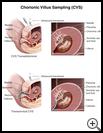
Chorionic Villus Sampling (Genetic Test) during Pregnancy
________________________________________________________________________
KEY POINTS
- Chorionic villus sampling is a test that takes a small sample of tissue from the placenta. The tissue sample can help you know early in a pregnancy if the baby has a genetic condition such as Down syndrome.
- You may not be able to have this test if your uterus is not in a normal position or if you have a vaginal infection.
- Your provider will either insert a thin plastic tube called a catheter into your vagina, or insert a needle through your belly to get a sample of tissue from the placenta.
- Talk to your healthcare provider about what the test results mean and ask any questions you have.
________________________________________________________________________
What is chorionic villus sampling?
Chorionic villus sampling (CVS) is a test that may be done early in pregnancy. The test takes a small sample of tissue from the placenta. The tissue sample can help you know early in a pregnancy if the baby has a genetic condition such as Down syndrome.
CVS can be done earlier in pregnancy than amniocentesis, which is another test that checks for genetic problems. With CVS, you can usually have the results of genetic tests before the 14th week of pregnancy. If test results show that your baby does have a problem, your healthcare provider will talk to you about your choices for treatment. The information can help you decide how to manage a pregnancy with a baby affected by the problem.
When is it used?
The test is usually done between the 10th and 13th weeks of pregnancy.
You may consider having CVS because:
- You will be 35 or older on the baby's due date.
- You or the baby's father has a family history of genetic problems
- You have been pregnant before with a child who had a birth defect
- You have had 3 or more miscarriages
- Other tests show the baby might have a problem
CVS may be more difficult to do if you are pregnant with more than 1 baby. Also, you may not be able to have CVS if your uterus is not in a normal position.
Sometimes it’s not possible to get an accurate result from CVS, and your healthcare provider may recommend amniocentesis instead.
How do I prepare for this test?
If you have a vaginal infection, it should be treated before the test. For this reason, your healthcare provider will check for infection with cultures of the cervix before the test. CVS can be done if the cultures show that you do not have an infection.
What happens during the test?
Your healthcare provider may get the small sample of tissue from the placenta in 1 of 2 ways:
- Your provider may insert a thin plastic tube called a catheter into the vagina and through the cervix to reach the placenta.
- Your provider may insert a needle through your belly and uterus and into the placenta. This method for getting tissue is similar to amniocentesis.
Both ways use ultrasound to guide the catheter or needle.
What happens after the test?
You may have some test results in 3 to 4 days. You can usually expect the final results within 2 weeks.
Ask your healthcare provider:
- How and when you will get your test results
- How long it will take to recover
- If there are activities you should avoid and when you can return to your normal activities
- How to take care of yourself at home
- What symptoms or problems you should watch for and what to do if you have them
Make sure you know when you should come back for a checkup. Keep all appointments for provider visits or tests.
What are the risks of this test?
There is risk with every treatment or procedure. The risk of most complications from this test is very low. Some possible risks include:
- You may have a miscarriage.
- You may have infection or bleeding.
- The needle may harm the baby if CVS is done earlier than the 10th week after your last menstrual period.
Normal test results do not always mean that the baby will be normal. Also, in very rare cases, an abnormal result may not be accurate.
Ask your healthcare provider how these risks apply to you. Be sure to discuss any other questions or concerns that you may have.

